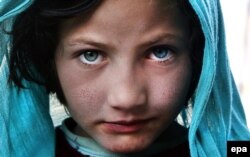Nine-year-old Fatima, who like many Afghans goes by one name only, should be going to school to pursue her dream of teaching at one someday.
Instead, for a daily wage of only a couple dollars, she sells pens to passing cars on the dusty streets of Afghanistan’s capital, Kabul.
“I run after cars and say, ‘Please buy my pens,’ but they don’t,” she told Radio Free Afghanistan.
She is yet not ready to give up on her hope of becoming a teacher. The sight of children going to school or returning from one saddens her often. “I get sad. I wish I could go to school,” she said.
Fatima is one of scores of young, female street vendors in Kabul, who are vulnerable to sexual abuse and exploitation while they work to save their impoverished families from hunger.
She hates being a street vendor, but her family’s poverty forces her to spend long hours on the noisy, traffic-clogged Kabul streets. When she complains to her mother that she is too young to work, she is given a stern reply: Work!
“I do not like being a vendor at all,” she says. “I would like to play with toys and go to the park.”
Fatima is one of hundreds of underage girls selling pens, calendars, plastic bags, tissues, books, magazines, and chewing gum to passing cars. While afflicted by poverty and misfortune, they have to put up with constant harassment.
Kayenat has sold plastic bags on the streets of Kabul since 2013, when she was only 6 years old. She is exposed to daily harassment from drivers.
“Men ask me to get in their cars and go with them. They promise to pay me money,” she told Radio Free Afghanistan. “I tell them, ‘Uncle give me money for the things I sell here; if you won’t then please go away.’ My father tells me every day to tell the men the same thing.”
Kayenat, a fourth grader, is working very hard to continue her education. She goes to school in the mornings but spends her afternoons and evenings on the streets.
“If I don’t work, we will go hungry. Who will pay for our flour? Who will buy us bread?” she asks.
Meena, 7, is a third grader who lives in Kabul’s Qala-e Wazir district. She occasionally goes out onto the streets to supplement her family’s meager income. During her recent winter school holidays, she sold plastic bags for more than seven hours a day to earn less than $3.
“My father is poor. He is a vendor. He asked me to sell bags to buy oil and other things,” she told Radio Free Afghanistan. “I give the money to my father, and he buys oil and bread for us.”
Suraya Subhrang, a senior official at the Afghan Independent Human Rights Commission (AIHRC), says she is worried that Kabul’s street vendor girls face the threat of sexual abuse in addition to economic exploitation as child workers.
“In addition of economic abuse, they [girl vendors] might face sexual abuse. In fact, there is a possibility of any kind of danger,” she said. “Some of these girls are quite pretty. Sometimes passing cars honk at them. [Sometimes drivers stop] to offer the girls money. [Sometimes these men tell them] ‘Come be my daughter, come be my wife.’ The girls feel embarrassed and run away from the car.”
Afghanistan’s Minister of Labor, Social Affairs, Martyrs and Disabled Nasrin Oryakhel says girl vendors are mistreated and oppressed.
“A continuation of this situation is a tragedy for the future of Afghanistan,” she told Radio Free Afghanistan. “I hope that Afghan mothers, despite their economic problems, will not let their daughters be hunted by wild men.”
Oryakhel says the authorities still do not know exactly how many underage female vendors work on Kabul’s streets, but her ministry is now planning to gather statistics.
Subhrang says AIHRC has no statistics either, because no girls or anyone on their behalf have filed complaints to the commission. But she, too, estimates there are hundreds of underage girl vendors on the streets of Kabul.
According to AIHRC, a majority of these girls are between 4 and 10 years old.
“Firstly, they should be identified, and those who are really needy and belong to poor families must be assisted. Also, the families must be helped and receive job opportunities,” AIHRC commissioner Subhrang said. “Then, those who recruited and abuse some of these girls should be identified. The abusers must be brought to justice and be punished.”
UNICEF says the Afghan government is responsible for rescuing street vendor children and preventing others from joining them.
Aziz Frotan, a UNICEF spokesman in Kabul, says the government needs to do more.
“In the government budget no attention has been paid to these children,” he said. “Members of the Afghan Parliament must make this issue a priority.”
Oryakhel, the social affairs minister, says most of the hawker girls come from families of widows or whose fathers are drug addicts or are disabled from the long years of war in Afghanistan.
She says her ministry provides professional training to widows to help them earn a sustainable living.
“In addition, we will launch a program in Kabul this year to support women who are on their own,” Nasrin said.
Jawid Hasanzada and Masooda Niazi contributed reporting from Kabul.
as/fg






